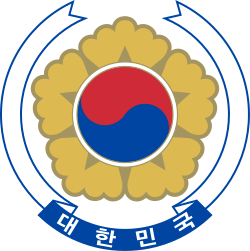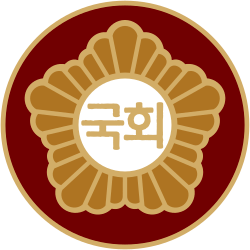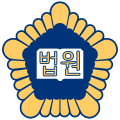South Korean legislative election, 1973
|
| |||||||||||||||||||||||||||||||
| |||||||||||||||||||||||||||||||
All 219 seats to the National Assembly and 73 Presidential appointees 110 seats needed for a majority | |||||||||||||||||||||||||||||||
|---|---|---|---|---|---|---|---|---|---|---|---|---|---|---|---|---|---|---|---|---|---|---|---|---|---|---|---|---|---|---|---|
| Turnout |
72.9% ( | ||||||||||||||||||||||||||||||
| |||||||||||||||||||||||||||||||
 |
|---|
| This article is part of a series on the politics and government of the Republic of Korea |
| Constitution |
|
Judiciary |
Legislative elections were held in South Korea on 27 February 1973.[1]
The result was a victory for the ruling Democratic Republican Party, which won 73 of the 146 elected seats in the National Assembly. With one-thirds of seats appointed by President Park Chung-hee, the ruling party had a supermajority. Voter turnout was 72.9%.
The election reconstituted the National Assembly after Park had dissolved it in the October Restoration self-coup four months earlier and pushed through a constitutional referendum which removed presidential term limits and gave him the power to appoint one-third of the National Assembly.[2] The opposition New Democratic Party had also split in 1972 over a leadership dispute between the Yu Chin-san faction and an opposing faction led by Kim Dae-jung and Kim Hong-il.[3] One month before the election, the latter formed the Democratic Unification Party.[4][5] However, the DUP performed poorly and split the opposition vote, and in the aftermath the members expressed regret for their decision to run.[6]
Results
| Party | Votes | % | Seats | +/– |
|---|---|---|---|---|
| Democratic Republican Party | 4,251,754 | 38.7 | 73 | –40 |
| New Democratic Party | 3,577,300 | 32.5 | 52 | –37 |
| Democratic Unification Party | 1,114,204 | 10.2 | 2 | New |
| Independents | 2,048,178 | 18.6 | 19 | New |
| Presidential appointees | – | – | 73 | New |
| Invalid/blank votes | 205,048 | – | – | – |
| Total | 11,196,484 | 100 | 219 | +15 |
| Source: Nohlen et al. | ||||
References
- ↑ Dieter Nohlen, Florian Grotz & Christof Hartmann (2001) Elections in Asia: A data handbook, Volume II, p420 ISBN 0-19-924959-8
- ↑ Lee, Kap-Yun (1999). "The Votes Mattered: Decreasing Party Support under the Two-Member-District SNTV in Korea (1973–1978)". In Grofman, Bernard; Lee, Sung-Chull; Winckler, Edwin; Woodall, Brian. Elections in Japan, Korea, and Taiwan Under the Single Non-Transferable Vote: The Comparative Study of an Embedded Institution. University of Michigan Press. p. 252. ISBN 9780472109098.
- ↑ "新民全黨大會 珍山系만으로 强行" [New Democratic Party convention: Chin-san faction alone pushes it through]. The Dong-a Ilbo (in Korean). 26 September 1972. p. 1. Retrieved 16 May 2018 – via Naver News Library.
- ↑ "金弘壹씨系 新民黨 떠나기로 鄭一亨씨는 殘留" [Kim Hong-il faction leaves New Democratic Party, Chyung Yil-hyung remains]. Kyunghyang Shinmun (in Korean). 18 January 1973. p. 1. Retrieved 12 May 2018 – via Naver News Library.
- ↑ "金弘壹씨新民脫党 民統党에參与할듯" [Kim Hong-il will leave New Democratic Party and join Democratic Unification Party]. Maeil Business Newspaper (in Korean). 19 January 1973. p. 1. Retrieved 12 May 2018 – via Naver News Library.
- ↑ "統一黨간부들, 總選참여를후회" [Unification Party leaders regret participation in general election]. Kyunghyang Shinmun (in Korean). 3 March 1973. p. 2. Retrieved 12 May 2018 – via Naver News Library.



